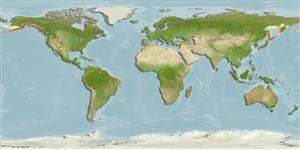Common names from other countries
Environment: milieu / climate zone / depth range / distribution range
Ecología
marino demersal; rango de profundidad ? - 91 m (Ref. 2850). Temperate
North Pacific: Kamchatka, Russia through the Aleutian chain and the Bering Sea to the Bering Strait coasts of Alaska and Humboldt Bay, California, USA.
Tamaño / Peso / Age
Maturity: Lm ? range ? - ? cm
Max length : 42.0 cm TL macho / no sexado; (Ref. 2850)
Short description
Claves de identificación | Morfología | Morfometría
Espinas dorsales (total) : 61 - 62; Radios blandos dorsales (total) : 0; Espinas anales: 1; Radios blandos anales: 44 - 51. Caudal rounded (Ref. 6885). Pale brown with white to cream markings, paler below; irregular light areas on upper part of body, and vertical light bars below; dark bars run down from eyes; prominent dark bars on the dorsal, caudal and anal fins (Ref. 6885).
Usually among seaweed on rocky bottoms (Ref. 2850); in reef crevices, usually among algae (Ref. 51666). Occurs in subtidal areas to 91 m depth (Ref. 2850).
Life cycle and mating behavior
Maturities | Reproducción | Spawnings | Egg(s) | Fecundities | Larva
Eschmeyer, W.N., E.S. Herald and H. Hammann, 1983. A field guide to Pacific coast fishes of North America. Boston (MA, USA): Houghton Mifflin Company. xii+336 p. (Ref. 2850)
IUCN Red List Status (Ref. 130435)
CITES (Ref. 128078)
Not Evaluated
Threat to humans
Harmless
Human uses
Pesquerías: comercial; Acuario: Acuarios públicos
Herramientas
Special reports
Download XML
Fuentes de Internet
Estimates based on models
Preferred temperature (Ref.
115969): 4.1 - 10.4, mean 8 (based on 180 cells).
Phylogenetic diversity index (Ref.
82804): PD
50 = 0.5039 [Uniqueness, from 0.5 = low to 2.0 = high].
Bayesian length-weight: a=0.00372 (0.00147 - 0.00941), b=3.17 (2.95 - 3.39), in cm Total Length, based on LWR estimates for this (Sub)family-body shape (Ref.
93245).
Nivel trófico (Ref.
69278): 3.6 ±0.5 se; based on size and trophs of closest relatives
Resiliencia (Ref.
120179): Muy bajo, población duplicada en un tiempo mínimo superior a 14 años (Preliminary K or Fecundity.).
Fishing Vulnerability (Ref.
59153): Low to moderate vulnerability (32 of 100).
